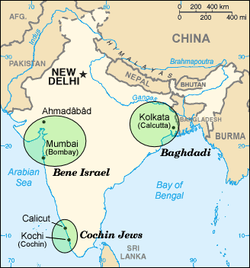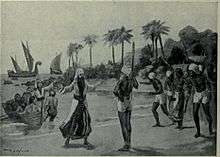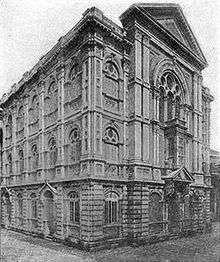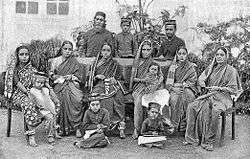History of the Jews in India

The history of the Jews in India reaches back to ancient times.[1][2][3]
Judaism was one of the first foreign religions to arrive in India in recorded history.[4] Indian Jews are a religious minority of India, but unlike many parts of the world, have historically lived in India without any instances of antisemitism from the local majority populace, the Hindus.[5] The better-established ancient communities have assimilated a large number of local traditions through cultural diffusion.[6] The Jewish community of India is the fourth largest Asian Jewish community after Israel, Asian Russia, and Iran. The Jewish population in India is hard to estimate, since each Jewish community is distinct with different origins; while some allegedly arrived during the time of the Kingdom of Judah, others are seen by some as descendants of Israel's Ten Lost Tribes.[7] In addition to Jewish expatriates[8] and recent immigrants, there are seven Jewish groups in India:
- The 'black' Malabar component of the Cochin Jews, according to Shalva Weil, might have arrived in India together with Solomon's merchants. The Cochin Jews settled down in Kerala as traders.[1] The 'white' component is of European and other Jewish descent.[9]
- Chennai Jews: The so-called Spanish and Portuguese Jews , Paradesi Jews and British Jews arrived at Madras during the 16th century, they were diamond businessmen,[10] and of Sephardi heritage. Following expulsion from Iberia in 1492 by the Alhambra Decree, a few families of Sephardic Jews eventually made their way to Madras in the 16th century. They maintained trade connections to Europe, and their language skills were useful. Although the Sephardim spoke Ladino (i.e. Spanish or Judeo-Spanish), in India they learned Tamil and Judeo-Malayalam from the Malabar Jews.[11]
- The Jews of Goa: These were Portuguese Jews who fled to the Portuguese Goa after the commencement of the Inquisition in Portugal. The community consisted mainly of "New-Christians" who were Jews by blood and had converted under the duress of the Inquisition. This group was the target of heavy persecution with the start of the Goan Inquisition, which put on trial famed physician Garcia de Orta, among others.
- Another branch of the Bene Israel community resided in Karachi until the Partition of India in 1947, when they fled to India (in particular, to Mumbai). Many of them also moved to Israel. The Jews from Sindh, Punjab or Pathan area are often incorrectly called Bani Israel Jews. The Jewish community who used to reside in other parts of what became Pakistan (such as Lahore or Peshawar) also fled to India in 1947, in a similar manner to the larger Karachi Jewish community.
- The Baghdadi Jews arrived in the city of Surat from Iraq (and other Arab states), Iran and Afghanistan about 250 years ago.[2]
- The Bnei Menashe are Mizo and Kuki tribesmen in Manipur and Mizoram who are recent converts to Judaism.[12]
- The Bene Ephraim (also called "Telugu Jews") are a small group who speak Telugu; their observance of Judaism dates to 1981.
Cochin Jews


The oldest of the Indian Jewish communities is in Cochin.[1][13] The traditional account is that traders from Judea arrived in the city of Cochin, Kerala, in 562 BCE, and that more Jews came as exiles from Israel in the year 70 CE. after the destruction of the Second Temple.[14] It is also believed that the Jews settled in India when King Solomon was in power. This was a time that teak, ivory, spices, and peacock were popular in trade in Cochin. There is no exact date or reason to why they arrived in India but scholars date it to around the early Middle Ages. Cochin is a group of small tropical islands filled with markets and many different cultures such as Dutch, Hindu, Jewish, Portuguse, and British.[15] The distinct Jewish community was called Anjuvannam. The still-functioning synagogue in Mattancherry belongs to the Paradesi Jews, the descendants of Sephardim that were expelled from Spain in 1492,[14] although the Jewish community in Mattancherry had only six remaining members as of 2015.[16]
Central to the history of the Cochin Jews is their close relationship with Indian rulers, and this was eventually codified on a set of copper plates granting the community special privileges. The date of these plates, known as "Sâsanam",[17] is contentious. The plates themselves provide a date of 379 CE, but in 1925 tradition was setting it as 1069 CE,[18] Joseph Rabban by Bhaskara Ravi Varma, the fourth ruler of Maliban granted the copper plates to the Jews. The plates were inscribed with a message stating that the village of Anjuvannam belonged to the Jews and that they were the rightful lords of Anjuvannam and it should remain theirs and be passed on to their Jewish descendants "so long as the world and moon exist." This is the earliest document that shows that the Jews were living in India permanently. It is now stored in Cochins main synagogue.[19] The Jews settled in Kodungallur (Cranganore) on the Malabar Coast, where they traded peacefully, until 1524. The Jewish leader Joseph Rabban was granted the rank of prince over the Jews of Cochin, given the rulership and tax revenue of a pocket principality in Anjuvannam, near Cranganore, and rights to seventy-two "free houses".[20] The Hindu king gave permission in perpetuity (or, in the more poetic expression of those days, "as long as the world and moon exist") for Jews to live freely, build synagogues, and own property "without conditions attached".[21][22] A link back to Rabban, "the king of Shingly" (another name for Cranganore), was a sign of both purity and prestige. Rabban's descendants maintained this distinct community until a chieftainship dispute broke out between two brothers, one of them named Joseph Azar, in the 16th century. The Jews lived peacefully for over a thousand years in Anjuvannam. After the reign of the Rabban's, the Jewish people no longer had the protection of the copper plates. Neighboring princes of Anjuvannam intervened and revoked all privileges that the Jewish people were given. In 1524, the Jews were attacked by the Moors brothers on a suspicion that they were messing with the pepper trade and the homes and synagogues belonging to them were destroyed. The damage was so extensive that when the Portuguese arrived a few years later, only a small amount of impoverished Jews remained. They remained there for 40 more years only to return to their land of Cochin.[19]
In Mala, Thrissur District, the Malabar Jews have a Synagogue and a cemetery, as well as in Chennamangalam, Parur and Ernakulam.[23]
Chennai Jews
Jews also settled in Madras (now Chennai) soon after its founding in 1640.[24] Most of them were coral merchants from Leghorn, Caribbean, London, Amsterdam who were of Portuguese origin and belonged to the Henriques De Castro, Franco, Paiva or Porto families.[24]
Jacques (Jaime) de Paiva (Pavia), originally from Amsterdam, was an early Jewish arrival and a leader of the community. He established good relations with those in power and bought several mines. Through his efforts, Jews were permitted to live within Fort St. George.[25]
De Paiva died in 1687 after a visit to his mines and was buried in the Jewish cemetery he had established in Peddanaickenpet, which later became the north Mint Street.[25][lower-alpha 1] In 1670, the Portuguese population in Madras numbered around 3000. Before his death he established ‘The Colony of Jewish Traders of Madraspatam’ with Antonio do Porto, Pedro Pereira and Fernando Mendes Henriques.[25] This enabled more Portuguese Jews, from Leghorn, the Caribbean, London and Amsterdam, to settle in Madras. Coral Merchant Street was named after the Jews' business.[27]
Three Portuguese Jews were nominated to be aldermen of Madras Corporation.[28] Three - Bartolomeo Rodrigues, Domingo do Porto and Alvaro da Fonseca - also founded the largest trading house in Madras. The large tomb of Rodrigues, who died in Madras in 1692, became a landmark in Peddanaickenpet but was later destroyed.[29]
Samuel de Castro came to Madras from Curaçao and Salomon Franco came from Leghorn.[25][30]
In 1688, there were three Jewish representatives in the Madras Corporation.[24] Most Jewish settlers resided in the Coral Merchants Street in Muthialpet.[24] They also had a cemetery in the neighbouring Peddanaickenpet.[24]
Bene Israel
Foreign notices of the Bene Israel go back at least to 1768, when Yechezkel Rahabi wrote to a Dutch trading partner that they were widespread in Maharatta Province, and observed two Jewish observances, recital of the Shema and observation of Shabbat rest.[31] The legend of their origins claims that they descend from ancestors, 14 Jewish men and women, equally divided by gender, who survived the shipwreck of refugees from persecution or political turmoil, and came ashore at Navagaon near Alibag, 20 miles south of Mumbai, some 17 to 19 centuries ago.[31] They were instructed in the rudiments of normative Judaism by Cochin Jews.[31] Their Jewishness is controversial, and initially as not accepted by the Rabbinate in Israel.[31] Since 2009 however they intermarry throughout Israel and are considered Israeli and Jewish in all respects.[32]
They are divided into subcastes, which do not intermarry: 'Black' (Kara) and White (Gora), the latter believed to be lineal descendants of the shipwreck survivors, while the former are considered to descend from concubinage of a male with local women.[31] They were nicknamed the shanivār telī ("Saturday oil-pressers") by the local population as they abstained from work on Saturdays, Judaism's Bene Israel communities and synagogues are situated in Pen, Mumbai, Alibag, Pune and Ahmedabad with smaller communities scattered around India. The largest synagogue in Asia outside Israel is in Pune (Ohel David Synagogue).
Mumbai had a thriving Bene Israel community until the 1950s to 1960s when many families from the community emigrated to the fledgling state of Israel, where they are known as Hodi'im (Indians).[31] The Bene Israel community has risen to many positions of prominence in Israel.[33] In India itself the Bene Israel community has shrunk considerably with many of the old Synagogues falling into disuse.
Unlike many parts of the world, Jews have historically lived in India without any instances of antisemitism from the local majority populace, the Hindus.[34] However, Jews were persecuted by the Portuguese during their control of Goa.[35]
Bombay/Mumbai
South Asian Jews & Baghdadi Jews

The first known Baghdadi Jewish immigrant to India, Joseph Semah, arrived in the port city of Surat in 1730. He and other early immigrants established a synagogue and cemetery in Surat, though most of the city's Jewish community eventually moved to Bombay (Mumbai), where they established a new synagogue and cemetery. They were traders and quickly became one of the most prosperous communities in the city. As philanthropists, some donated their wealth to public structures. The Sassoon Docks and David Sassoon Library are some of the famous landmarks still standing today.
The synagogue in Surat was eventually razed; the cemetery, though in poor condition, can still be seen on the Katargam-Amroli road. One of the graves within is that of Moseh Tobi, buried in 1769, who was described as 'ha-Nasi ha-Zaken' (The Elder Prince) by David Solomon Sassoon in his book A History of the Jews in Baghdad (Simon Wallenburg Press, 2006, ISBN 184356002X).
Baghdadi Jewish populations spread beyond Bombay to other parts of India, with an important community forming in Calcutta (Kolkata). Scions of this community did well in trade (particularly jute and tea), and in later years contributed officers to the army. One, Lt-Gen J. F. R. Jacob PVSM, became state governor of Goa (1998–99), then Punjab, and later served as administrator of Chandigarh. Pramila (Esther Victoria Abraham) became the first ever Miss India, in 1947.
Bnei Menashe
The Bnei Menashe are a group of more than 9,000 people from the northeastern Indian states of Mizoram and Manipur[12] who practice a form of biblical Judaism and claim descent from one of the Lost Tribes of Israel.[36] Many were converted to Christianity and were originally headhunters and animists at the beginning of the 20th century, but began converting to Judaism in the 1970s.[37]
Bene Ephraim
The Bene Ephraim are a small group of Telugu-speaking Jews in eastern Andhra Pradesh whose recorded observance of Judaism, like that of the Bnei Menashe, is quite recent, dating only to 1981.
There are a few families in Andhra Pradesh who follow Judaism. Many among them follow the customs of Orthodox Jews like long side locks in male hair, having head covering all the time etc.[38]
Delhi Jewry
Judaism in Delhi is primarily focused on the expatriate community who work in Delhi, as well as Israeli diplomats and a small local community. In Paharganj, Chabad has set up a synagogue and religious center in a backpacker area regularly visited by Israeli tourists.
Today
The majority of Indian Jews have "made Aliyah" (migrated) to Israel since the creation of the modern state in 1948. Over 70,000 Indian Jews now live in Israel (over 1% of Israel's total population). Of the remaining 5,000, the largest community is concentrated in Mumbai, where 3,500 have stayed over from the over 30,000 Jews registered there in the 1940s, divided into Bene Israel and Baghdadi Jews,[39] though the Baghdadi Jews refused to recognize the B'nei Israel as Jews, and withheld dispensing charity to them for that reason.[31] There are reminders of Jewish localities in Kerala still left such as Synagogues. Majority of Jews from the old British-Indian capital of Calcutta (Kolkata) have also migrated to Israel over the last six decades.
Notable Indian Jews
- Eli Ben-Menachem - Israeli politician.
- Jacqueline Bhabha - Lecturer at Harvard Law School and Harvard Kennedy School of Government.
- Ranjit Chaudhry - Bollywood actor
- David Abraham Cheulkar - Bollywood actor.
- Reuben David (1912 - 1989) Zoologist [40]
- Esther David (March 17, 1945— ) is a Jewish-Indian author, an artist and a sculptor[41]
- Nadira - Bollywood Actress
- Karen David - British-Canadian actress
- Nissim Ezekiel - poet, playwright, editor and art-critic.
- Lieutenant General J F R Jacob - Former Chief of Staff of the Indian Army's Eastern Command; Former Governor of Punjab and Goa.
- Ruth Prawer Jhabvala - Writer who moved to India when she was 24 and lived here for 24 years till she emigrated to USA.
- Gerry Judah - Artist and Designer.
- Ellis Kadoorie and Elly Kadoorie - Philanthropists.
- Horace Kadoorie - Philanthropist.
- Anish Kapoor - Sculptor.
- Samson Kehimkar - Musician
- Ezekiel Isaac Malekar - Bene Israel Rabbi.
- Ruby Myers, Bollywood actress of the 1920s known as Sulochana.
- Pearl Padamsee - Theatre personality.
- Joseph Rabban - Was given copper plates of special grants from the Chera ruler Bhaskara Ravivarman II from Kerala.
- David and Simon Reuben - Businessmen.
- Abraham Barak Salem - Cochin Jewish Indian nationalist leader.
- Aditya Roy Kapur - Bollywood actor.
- Lalchanhima Sailo - Rabbi and Founder of Chhinlung Israel People's Convention.
- David Sassoon - Businessman.
- Albert Abdullah David Sassoon - British Indian merchant.
- Sassoon David Sassoon - Philanthropist and benefactor of greater Indian Jewish community.
- Solomon Sopher - Jewish community leader in Mumbai.
- Bensiyon Songavkar - Professional cricketer.
- Esther Victoria Abraham - aka Pramila. First ever Miss India.
- Fleur Ezekiel - Bene Israel model was chosen as Miss World in 1959
Notes
References
- 1 2 3 The Jews of India: A Story of Three Communities by Orpa Slapak. The Israel Museum, Jerusalem. 2003. p. 27. ISBN 965-278-179-7.
- 1 2 Weil, Shalva.India's Jewish Heritage: Ritual, Art and Life-Cycle. Mumbai: Marg Publications [first published in 2002; 3rd edn.]. 2009.
- ↑ "Solomon To Cheraman".
- ↑ Weil, Shalva. "Indian Judaic Tradition" in Sushil Mittal and Gene Thursby (eds) Religions in South Asia, London: Palgrave Publishers, 2006. pp. 169-183.
- ↑ Weiss, Gary (August 13, 2007). "India's Jews". Forbes. Retrieved July 9, 2016.
- ↑ Weil, Shalva. "Bene Israel Rites and Routines" in Shalva Weil (ed.) India’s Jewish Heritage: Ritual, Art and Life-Cycle, Mumbai: Marg Publications, 2009. [first published in 2002; 3Arts, 54(2): 26-37.
- ↑ Weil, Shalva. (1991) "Beyond the Sambatyon: the Myth of the Ten Lost Tribes." Tel-Aviv: Beth Hatefutsoth, the Nahum Goldman Museum of the Jewish Diaspora.
- ↑ Weil, Shalva. "From Persecution to Freedom: Central European Jewish Refugees and their Jewish Host Communities in India" in Anil Bhatti and Johannes H. Voigt (eds) Jewish Exile in India 1933-1945, New Delhi: Manohar and Max Mueller Bhavan,1999. pp. 64-84.
- ↑ Weil, Shalva. "Cochin Jews", in Judith Baskin (ed.) Cambridge Dictionary of Judaism and Jewish Culture, New York: Cambridge University Press, 2011. pp. 107.
- ↑ http://www.thehindu.com/thehindu/mp/2002/09/30/stories/2002093000180300.htm
- ↑ Katz 2000; Koder 1973; Thomas Puthiakunnel 1973.
- 1 2 Weil, Shalva. "Lost Israelites from North-East India: Re-Traditionalisation and Conversion among the Shinlung from the Indo-Burmese Borderlands." The Anthropologist, 2004. 6(3): 219-233.
- ↑ Weil, Shalva. "Cochin Jews," in Carol R. Ember, Melvin Ember and Ian Skoggard (eds) Encyclopedia of World Cultures Supplement, New York: Macmillan Reference USA, 2002. pp. 78-80.
- 1 2 Schreiber, Mordecai (2003). The Shengold Jewish Encyclopedia. Rockville, MD: Schreiber Publishing. p. 125. ISBN 1887563776.
- ↑ Meyer, Raphael. "Jews of India- The Cochin Jews". The-south-asian.
- ↑ Pinsker, Alyssa (October 22, 2015). "The last six Paradesi Jews of Cochin". BBC. Retrieved July 2, 2016.
- ↑ Burnell, Indian Antiquary, iii. 333–334
- ↑ Katz, Nathan (2000). Who are the Jews of India?. University of California Press. p. 33. ISBN 9780520213234.
- 1 2 Meyer, Raphael. "Jews of India-Cochin Jews". The-south-asian.
- ↑ taken from WP article on Rabban, which appears to rely on Ken Blady's book Jewish Communities in Exotic Places. Northvale, N.J.: Jason Aronson Inc., 2000. pp. 115–130. Weil, Shalva. "Symmetry between Christians and Jews in India: the Cnanite Christians and the Cochin Jews of Kerala." Contributions to Indian Sociology, 1982. 16(2): 175-196.
- ↑ Three years in America, 1859–1862 (p. 59, p. 60) by Israel Joseph Benjamin
- ↑ Roots of Dalit history, Christianity, theology, and spirituality (p. 28) by James Massey, I.S.P.C.K.
- ↑ Weil, Shalva. "Where are Cochin Jews today? The Synagogues of Kerala, India." Cochinsyn.com, Friends of Kerala Synagogues. 2011.
- 1 2 3 4 5 Muthiah, S. (2004). Madras Rediscovered. East West Books (Madras) Pvt Ltd. p. 125. ISBN 81-88661-24-4.
- 1 2 3 4 Muthiah, S. (3 September 2007). "The Portuguese Jews of Madras". The Hindu. Retrieved 2016-05-24.
- ↑ Sundaram, Krithika (31 October 2012). "18th century Jewish cemetery lies in shambles, craves for attention". The New Indian Express. Retrieved 2016-07-12.
- ↑ Muthiah, S. (30 September 2002). "Will Chennai's Jews be there?". The Hindu. Retrieved 2016-05-24.
- ↑ Muthiah, S. (2014). Madras Rediscovered. Westland. ISBN 978-9-38572-477-0.
- ↑ Parthasarathy, Anusha (3 September 2013). "Lustre dims, legacy stays". The Hindu. Retrieved 2016-05-24.
- ↑ "Chennai - India". International Jewish Cemetery Project. Retrieved 2016-07-12.
- 1 2 3 4 5 6 7 Nathan Katz, Who Are the Jews of India?, California University Press, 2000 pp.91ff.
- ↑ Joseph Hodes,From India to Israel: Identity, Immigration, and the Struggle for Religious Equality, McGill-Queen's Press 2014 pp.98ff.108.
- ↑ Weil, Shalva. "Religious Leadership vs. Secular Authority: the Case of the Bene Israel." Eastern Anthropologist, 1996. 49(3- 4): 301-316.
- ↑ Weiss, Gary (August 13, 2007). "India's Jews". Forbes. Retrieved July 9, 2016.
- ↑ Who are the Jews of India? - The S. Mark Taper Foundation imprint in Jewish studies. University of California Press. 2000. p. 26. ISBN 978-0-520-21323-4.; "When the Portuguese arrived in 1498, they brought a spirit of intolerance utterly alien to India. They soon established an Office of Inquisition at Goa, and at their hands Indian Jews experienced the only instance of antisemitism ever to occur in Indian soil."
- ↑ http://www.bneimenashe.com/history.html
- ↑ "More than 7,200 Indian Jews to immigrate to Israel". The Times Of India. September 27, 2011.
- ↑ http://www.kulanu.org/india/thebeneephraim.php
- ↑ Rachel Delia Benaim, 'For India’s Largest Jewish Community, One Muslim Makes All the Tombstones,' Tablet 23 February 2015.
- ↑ http://www.estherdavid.com/reubendavid.html
- ↑ Weil, Shalva. "Esther David: The Bene Israel Novelist who Grew Up with a Tiger" in David Shulman and Shalva Weil (eds) Karmic Passages: Israeli Scholarship on India, New Delhi: Oxford University Press, 2008. pp. 232-253.
Further reading
- Aafreedi, Navras Jaat, ed., Café Dissensus, Issue 12: Indian Jewry, January 2015
- Aafreedi, Navras Jaat, "Community and Belonging in Indian Jewish Literature", Himal Southasian (ISSN 1012-9804), May 2014
- Aafreedi, Navras Jaat, "Absence of Jewish Studies in India: Creating A New Awareness", Asian Jewish Life (ISSN 2224-3011), Autumn 2010, pp. 31-34.
- Aafreedi, Navras Jaat, "Jewish-Muslim Relations in South Asia: Where Antipathy lives without Jews", Asian Jewish Life (ISSN 2224-3011), Issue 15, October 2014, pp. 13-16.
- Aafreedi, Navras Jaat, "The Attitudes of Lucknow's Muslims towards Jews, Israel and Zionism", Café Dissensus (ISSN 2373-177X), Issue 7, April 15, 2014
- Aafreedi, Navras Jaat, "History of India's Jewish Beauty Queens", Yedioth Ahronoth, August 3, 2013
- Aafreedi, Navras Jaat, "Hindi Novel Portrays Life of Indian Jews", Yedioth Ahronoth, May 23, 2013
- India's Bene Israel: A Comprehensive Inquiry and Sourcebook Isenberg, Shirley Berry; Berkeley: Judah L. Magnes Museum, 1988
- Indian Jewish Heritage: Ritual, Art and Life-Cycle Dr. Shalva Weil (ed). Mumbai: Marg Publications, 3rd ed. 2009
- Indo-Judaic Studies in the Twenty-First Century: A Perspective from the Margin, Katz N., Chakravarti, R., Sinha, B. M. and Weil, S., New York and Basingstoke, England: Palgrave Macmillan. 2007
- Karmic Passages: Israeli Scholarship on India,Shulman, D. and Weil, S. New Delhi: Oxford University Press.2008
External links
| Wikimedia Commons has media related to Judaism in India. |
- TheJewsOfIndia.com, Comprehensive Site of Jews in Inda
- Bneimenashe.com, Bnei Menashe Jews of North East India
- Haruth.com, Jewish India
- Indo-Judaic: Philosophy, Research, Studies and Cultural Community
- Tripod.com, Jews in India
- Jewsofindia.org, Jews of India, includes a Photo Gallery & a Forum
- Kulanu.org, Kulanu's Indian Jews page
- Abhishiv Saxena, "The Jews of India", Merinews.com (July 2, 2007)
- Indjews.com, The Indian synagogues in Israel
- Indian Jews - Jewish Encyclopedia
- Bene Israel - Jewish Encyclopedia
- Cochin Jews - Jewish Encyclopedia
- Calcutta Jews - Jewish Encyclopedia
- Indian Jews - Jewish Virtual Library
- Photos of Synagogues of Calcutta
- Information on synagogues in Kerala, India
- Shaar Hashamaim
- The Satamker family

